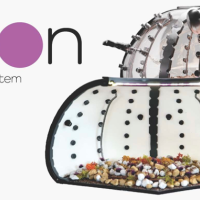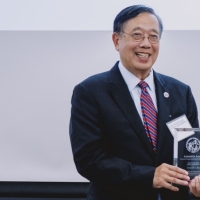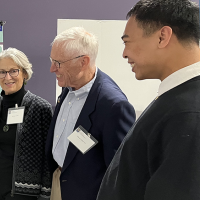by Patrick Monahan
Jim Gibson stands at a control panel steering the stars with rows of glowing switches while above him looms a 26-foot-tall starlit dome. It wouldn’t look out of place in a vintage sci-fi film. Yet it’s all tucked away in Thornton Hall behind a door that looks like the entry to any other classroom.
SF State’s planetarium is easy to miss if you don’t know it’s there. But for more than four decades, it’s been a launchpad for careers in astronomy and science education and a catalyst for learning about space.
“This is far and away from the best teaching tool I’ve ever encountered,” said Gibson, an SF State astronomy technician.
For those four decades, the planetarium has remained basically unchanged — including its centerpiece, the projector that displays pinpricks of light on the dome to represent the stars. “It was state-of-the-art in 1973,” said Professor of Physics and Astronomy Adrienne Cool, who runs the planetarium, “but it’s showing its age.”

Professor of Physics and Astronomy Adrienne Cool gives a demonstration to an elementary school class
That’s why the University is raising $1.5 million for a new one. “A new projector will bring us into the 21st century, but more modern tools at educators’ fingertips, and, with luck, last another 40 years,” Cool said.
The Charles F. Hagar Planetarium has stood in 422 Thornton Hall ever since the building was erected in 1973. Hagar, an astronomy professor at SF State for 35 years, designed the space. He envisioned it as a place where anyone could come to learn astronomy. Today the space is home to astronomy lab classes as well as free public showings and lessons for local public schools — a service that’s unique in the Bay Area — serving thousands of community members each year.
Other lessons teach students about how Earth’s tilt produces the seasons or about the constellations of the night sky. “That’s the astronomy that I feel people will take away from this and pass on to their kids and parents and neighbors,” said Cool.
The planetarium lets students learn how to craft their own shows, too. Vivian White, the director of free-choice learning at the Astronomical Society of the Pacific, got her start in astronomy education by giving shows in the planetarium as an undergraduate. “My biggest love is for the night sky, thanks to that planetarium,” she said. Other alumni can be found in science museums, astronomy outreach organizations, and other planetariums around the country.
On top of everything else, the planetarium provides a break from the sometimes hectic pace of city life. Every other Friday at noon, Gibson puts on a public show where the room is home to something akin to a meditation session. “I don’t talk,” he explained. “I just turn on the stars and let them drift across the sky.”





